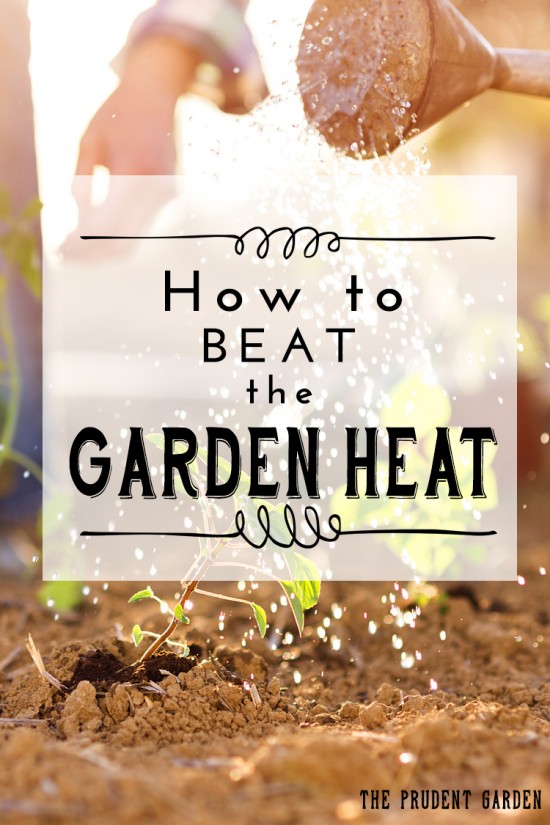Gardening In The Heat
Summer heat can really test your resolve to garden. You spent all spring getting things planted and established, then along come high temperatures, drought, weeds and bugs. Now you either must spend time cultivating, watering and harvesting; or give up and be defeated by discomfort.
Don’t mistake carelessness for commitment! Taking the risks of sun exposure and heat stress seriously, and protecting yourself from these dangers, is just as important in the garden as at the beach or on a construction site. Here are a few consideration and precautions you should take when gardening in hot weather.
Train Your Body
The human body is amazingly adaptable, but it doesn’t happen immediately. Air conditioning allows us to live our lives in comfort, but keeps our bodies’ natural cooling ability “rusty” because it is not often used. If you spend much of your time indoors, be especially mindful of gradually training your body to work in hot weather. Spend a little time each day moving and sweating outdoors so that by the weekend it won’t be such a shock to be hot for a few hours at a stretch.
Avoid Gardening In The Hottest Part Of The Day
My favorite time to work in the garden is the last two or three hours of daylight. At that time, I can do any chore that needs to get done without having to endure the brutal midday Georgia sun. Early morning is nice too, if you don’t mind being dew-soaked.
Stay Hydrated
You can’t sweat/cool yourself if you are low on fluids. It is important to begin the day hydrated by drinking twelve ounces of water before heading into the heat. While working, drink another 5-8 ounces every half hour. Your urine should be transparent (and plentiful!).
Cover Your Skin
I wear long sleeves, long pants and a broad-brimmed hat that shades my ears. Sometimes, I keep a wet towel on the back of my neck as well to help me stay comfortable. If you just can’t stand the long clothes, be sure to use SPF 30 or higher sunscreen.
Take Breaks
Work hard for an hour at a time, but make sure you take at least a ten minute break in the shade (with a cool drink) after each hour of work. This will allow your body to cool and your muscles to recover for a more productive day, less injury prone day.
Garden With A Partner
Two gardeners can watch out for each other’s heat safety by drinking and breaking together. They can also watch out for signs of heat stress, and administer first aid if necessary. If you go it alone, make sure someone who will check on you knows you’re out there.
Know The Signs Of Heat Stress
Heat exhaustion is a serious warning to cool yourself, and is closely linked to the heat index. When it’s hot and humid, sweat doesn’t evaporate easily, making it difficult for your body to cool itself and so the risk of heat exhaustion increases. Symptoms of heat exhaustion include:
- Confusion
- Dark colored urine
- Dizziness
- Fainting
- Fatigue
- Headache
- Muscle or abdominal cramps
- Nausea, vomiting, or diarrhea
- Pale skin
- Profuse sweating
- Rapid heartbeat
If you experience one or a combination of these symptoms, get into a cool place as soon as possible. Loosen any restricting clothes. Drink cool water. Take a cool shower. Symptoms should abate within fifteen minutes or so.
Heat stroke, also known as sunstroke, is a medical emergency, requiring immediate medical attention. It often occurs as a progression of untreated heat exhaustion. Symptoms of heat stroke include:
- Throbbing headache
- Dizziness/light-headedness
- Lack of sweating
- Red, hot, dry skin
- Muscle weakness or cramps
- Nausea and vomiting
- Rapid heartbeat (either strong or weak)
- Rapid, shallow breathing
- Behavioral changes (confusion, disorientation, staggering)
- Seizures
- Unconsciousness
For cases of suspected heat stroke, immediately call 9-1-1. While awaiting arrival of paramedics, administer first aid to cool the victim’s body temperature. Cooling tactics include: cool water immersion (or an ice bath); placing ice packs on areas where the blood vessels are close to the skin such as the back of the neck, armpits, groin and back; and fanning the victim while wetting the skin.




